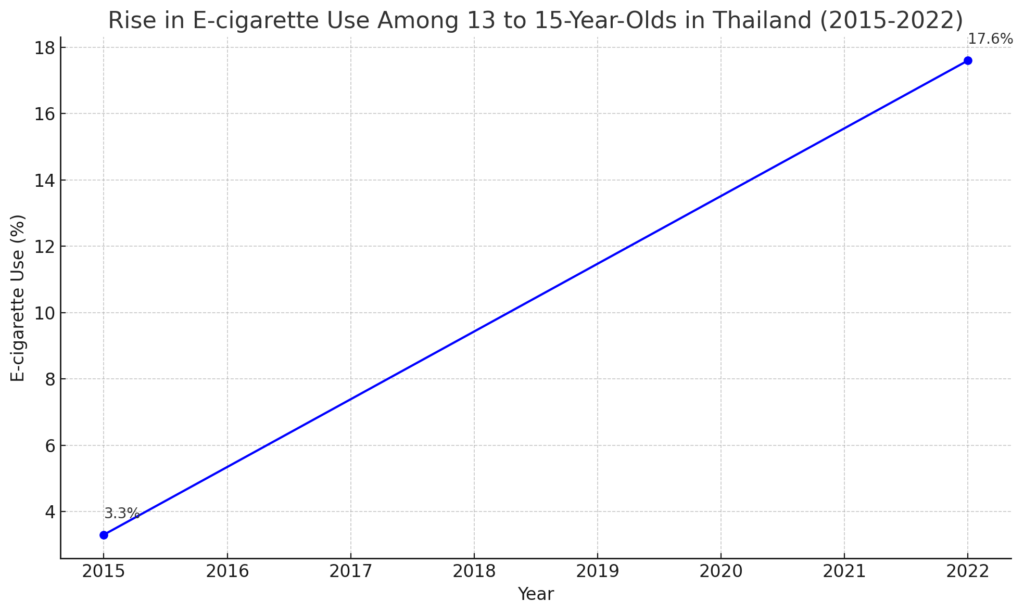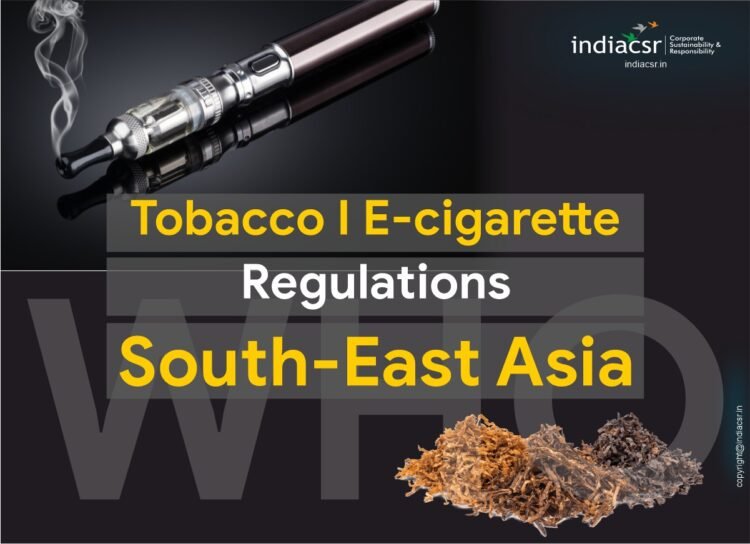By implementing comprehensive tobacco control measures, advocating for stricter policies, and tackling industry interference, the Region can build on its progress and protect the health of its citizens.
*******
NEW DELHI (India CSR): Despite a significant decline in tobacco use over the past two decades, the World Health Organization (WHO) is calling on countries in the South-East Asia Region to intensify their efforts to control both tobacco and e-cigarettes.
While the Region has seen impressive progress in reducing tobacco use among men, women, and youth, it still holds the unfortunate distinction of having the highest number of tobacco users globally. Additionally, the rise of e-cigarettes poses a new threat to public health in the Region.
While Bangladesh has announced “Tobacco Free Bangladesh by 2024, India has initiated ‘Tobacco Endgame’.
A Region Still Gripped by Tobacco
“The South-East Asia region continues to bear the brunt of the tobacco epidemic, with millions still using these harmful products, putting them at an increased risk of deadly diseases,” warned Ms. Saima Wazed, Regional Director, WHO South-East Asia. “While we have seen encouraging declines in tobacco use, urgent action is still needed to protect the health and save lives of our populations.”
Despite a drop from 68.9% in 2000 to around 43.7% in 2022, an estimated 411 million people in the region continue to consume tobacco.

Smokeless Tobacco and Youth Use: Double Trouble
The region shoulders a disproportionate burden of smokeless tobacco use, accounting for nearly 77% of global users. Additionally, around 11 million adolescents, constituting nearly 30% of the global total, fall victim to tobacco addiction.
Vaping Alarms Rise
The growing popularity of e-cigarettes, particularly among young people, further complicates the public health picture. Thailand, for instance, reported a startling surge in e-cigarette use among school-aged children, with the prevalence leaping from 3.3% in 2015 to 17.6% in 2022.
WHO Stands Firm
Ms. Wazed emphasized WHO’s unwavering commitment to supporting policies that counteract the influence of the tobacco and e-cigarette industries, safeguarding the health of over 2 billion people in the region.
Progress and Aspirations
Several countries, including DPR Korea, India, Nepal, Sri Lanka, Thailand, and Timor-Leste, have implemented e-cigarette bans. While applauding such steps, the WHO urges further action.
The region has demonstrated commendable progress in tobacco control, with tobacco use among men declining from 68.9% in 2000 to 43.7% in 2022, and among women from 33.5% to 9.4%, marking the steepest decline among all WHO regions.
India and Nepal are on track to achieve the NCD 2025 target of a 30% reduction in tobacco use by 2025, while eight other countries are projected to see declines, although falling short of the target.
Bangladesh has pledged to be “Tobacco Free Bangladesh by 2024,” while India has launched “Tobacco Endgame.”
The WHO commends these initiatives and urges sustained efforts to implement effective tobacco control measures, including those outlined in the WHO MPOWER package, while confronting the undue influence of the tobacco industry.
By taking decisive action, South-East Asia can create a future free from the grip of tobacco and e-cigarettes, safeguarding the health and well-being of its citizens.
******

India’s Strategic Approach to Combating Tobacco Usage
In September 2013, during the International Conference on Public Health Priorities in the 21st Century with a focus on “Endgame for Tobacco” held in New Delhi, Shri Ghulam Nabi Azad, the Union Minister for Health and Family Welfare, delivered the keynote speech. The event also saw participation from Dr. Margaret Chan, the Director General of the World Health Organization (WHO).
The minister highlighted India’s critical challenge with tobacco, noting that the country has the largest population of users of smokeless tobacco globally, leading to more than 1 million deaths annually in India due to tobacco-related causes. Furthermore, India records the highest number of oral cancer incidences worldwide, with 90% of these cases linked to the use of smokeless tobacco.
Shri Ghulam Nabi Azad emphasized the complexity of tackling tobacco use in India, given the wide array of tobacco products available, including both smoked and smokeless varieties. Citing data from the Global Adult Tobacco Survey (2009-10), he shared that approximately one in four Indians, or around 275 million people, consume tobacco in some form. Out of the nearly 35% of Indian adults who use tobacco, 21% engage in the use of smokeless tobacco products such as gutkha, zarda, and khaini, which are consumed orally. About 9% of the population smokes, while nearly 5% both smoke and use smokeless tobacco products.
*****
Tobacco Free Bangladesh by 2024
Bangladesh, a country known for its rich culture and history, is on a mission to become tobacco-free by 2024. This ambitious goal is not just a public health initiative, but a testament to the nation’s commitment to improving the quality of life for its citizens.
The Current Scenario
Tobacco consumption, both in the form of smoking and smokeless tobacco, is a significant public health issue in Bangladesh. It leads to numerous health problems, including heart disease, stroke, and various types of cancer. The economic burden of treating these diseases is immense, straining the country’s healthcare system.
The Plan
The government of Bangladesh has taken several steps to curb tobacco usage. These include imposing higher taxes on tobacco products, enforcing strict packaging and advertising rules, and promoting public awareness about the dangers of tobacco. The aim is to make tobacco products less accessible, less attractive, and less affordable.
*****
Introduction to Tobacco Control in the South-East Asia Region
Tobacco is recognized as the leading cause of preventable death worldwide, responsible for nearly 8 million deaths annually. The WHO South-East Asia Region (SEAR), a significant contributor to both the production and consumption of tobacco, sees 1.6 million of these deaths. Notably, India and Indonesia rank among the top five global tobacco producers.
The Prevalence of Tobacco Use in SEAR
The South-East Asia Region is notable for comprising 81 percent of the world’s smokeless tobacco users and more than 22 percent of the global adult smoker population aged 15 and above. Additionally, it hosts over a third of the global children population aged 13 to 15 years who use tobacco in various forms.
Trends in Tobacco Use Across SEAR
Despite the South-East Asia Region having the highest tobacco use prevalence among WHO regions, there is a notable decline in the age-standardized tobacco use prevalence rate. From an estimated total tobacco use rate of around 47% in 2000, it decreased to nearly 29% among adults aged 15 and older by 2018, with a target to reduce it further to about 25% by 2025.
Monitoring Tobacco Use in SEAR
The South-East Asia Region exhibits the highest measurable trends in tobacco use across its entire population among all WHO Regions. This indicates a robust monitoring system for the tobacco epidemic at the country level within the region.
The Dili Declaration on Tobacco Control
In 2015, the Dili Declaration was adopted to bolster the fight against tobacco through evidence-based policies, especially targeting the challenges posed by smokeless tobacco and Electronic Nicotine Delivery Systems (ENDS). This declaration marked a significant political commitment towards tobacco control in the region.
The Link Between Tobacco, Poverty, and Development
Tobacco use in the South-East Asia Region is intricately linked to poverty and development challenges, exacerbating the economic burden on national economies. It also plays a critical role in increasing the prevalence of tuberculosis and non-communicable diseases, emphasizing the importance of tobacco control at both regional and country levels.
WHO-SEARO’s Leadership in Tobacco Control
The WHO South-East Asia Regional Office (SEARO) leads tobacco control initiatives, coordinating global and regional actions to combat tobacco use through innovative, multi-sectoral responses. This includes the implementation of the WHO MPOWER package and Best Buys, contributing to the decline in smoking rates across the region.
Implementing Graphic Health Warnings and Legislation
SEAR countries have demonstrated leadership in implementing graphic health warnings on tobacco packs and adopting measures like Plain Packaging to deter tobacco use. Additionally, efforts to combat illicit trade in tobacco through the ratification of the WHO Framework Convention on Tobacco Control (FCTC) Protocol are notable achievements in the region.
Goal of the Tobacco Free Initiative (TFI) Unit of WHO-SEARO
The TFI Unit of WHO-SEARO aims to shield current and future generations from the harmful effects of tobacco use and exposure. By implementing comprehensive tobacco control policies, including the WHO FCTC and MPOWER package, the initiative strives to reduce tobacco prevalence and exposure to second-hand smoke, aligning with global health and sustainable development goals.
*****
Must Know Facts on Tobacco Use
- Tobacco causes nearly 8 million deaths yearly, with 1.6 million in SEAR.
- 81% of the world’s smokeless tobacco users and 22% of adult smokers are in SEAR.
- Tobacco use prevalence in SEAR is declining, targeting a 25% rate by 2025.
- The Dili Declaration focuses on accelerating tobacco control policies in SEAR.
- Tobacco’s impact in SEAR extends to poverty, health burdens, and economic strain.
- WHO-SEARO leads efforts in reducing smoking rates through the WHO MPOWER package.
- SEAR showcases leadership in tobacco control with graphic health warnings and Plain Packaging.
- The WHO-SEARO TFI Unit aims to reduce tobacco use and exposure to second-hand smoke.
*****
What is Tobacco and Tobacco Consuming
Tobacco is a product prepared from the leaves of the tobacco plant by curing them. It contains the alkaloid nicotine, which is a stimulant, and harmala alkaloids.
Tobacco Smoking is the act of smoking tobacco products, especially cigarettes and cigars1. The practice is believed to have begun as early as 5000–3000 BC.
In India, the most prevalent form of tobacco use is smokeless tobacco and commonly used products are khaini, gutkha, betel quid with tobacco and zarda. Smoking forms of tobacco used are bidi, cigarette and hookah.
Key Facts about Tobacco and Tobacco Smoking:
- Tobacco kills up to half of its users who don’t quit.
Tobacco kills more than 8 million people each year, including an estimated 1.3 million non-smokers who are exposed to second-hand smoke. - Around 80% of the world’s 1.3 billion tobacco users live in low- and middle-income countries.
All forms of tobacco use are harmful, and there is no safe level of exposure to tobacco. - Cigarette smoking is the most common form of tobacco use worldwide. Other tobacco products include waterpipe tobacco, cigars, cigarillos, heated tobacco, roll-your-own tobacco, pipe tobacco, bidis and kreteks, and smokeless tobacco products.
Tobacco use contributes to poverty by diverting household spending from basic needs such as food and shelter to tobacco.
The economic costs of tobacco use are substantial and include significant healthcare costs for treating the diseases caused by tobacco use as well as the lost human capital that results from tobacco-attributable morbidity and mortality.

*****
E-Cigarette
An electronic cigarette, also known as an e-cigarette or vape, is a device that simulates tobacco smoking. It consists of an atomizer, a power source such as a battery, and a container filled with liquid1. Instead of smoke, the user inhales vapor. The liquid inside may smell fruity, but it can have a high nicotine content.
When the user sucks on the mouthpiece, the heating element vaporizes the solution, which the person then “vapes,” or inhales.
E-cigarettes are made up of the following parts:
The mouthpiece: A cartridge fixed to the end of a tube. Inside is a small plastic cup containing absorbent material soaked in a liquid solution.
The atomizer: This heats the liquid, causing it to vaporize so that a person can inhale it.
The battery: This powers the heating element.
The sensor: This activates the heater when the user sucks on the device.
The solution: E-liquid, or e-juice, contains a combination of nicotine, a base, which is usually propylene glycol, and flavoring.
(India CSR)























